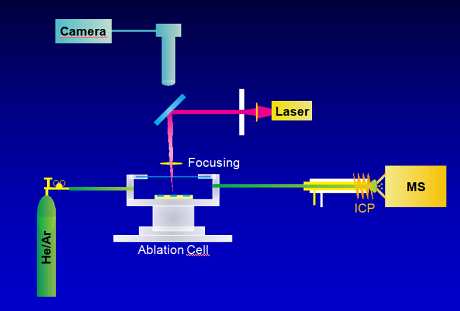Gel electrophoresis (GE) is the benchmark for high resolution protein separation, particularly in two-dimensional (2-D) format. However the application of GE for the speciation analysis of metallic-species is not straightforward.
Standard GE systems are not intended to meet the requirements of trace/ultratrace element analysis and so potentially may pose a trace element leaching/contamination hazard. The same applies to all the reagents and buffers used in gel processing. Also flat-bed electrophoresis or thin-layer chromatography are separation techniques that cannot be coupled on-line with ICP-MS. Since these techniques can be used to separate chemical compounds in two dimensions on the surface of coated plates or sheets, analytical techniques allowing the mapping of analytes on surfaces can be used to analyze such plates.

Figure: Experimental setup of LA-ICP-MS
Laser ablation - inductively coupled plasma mass spectrometry (LA-ICP-MS) is such a technique for imaging analysis and has been proposed for the analysis of gel plates already in 1998. With respect to metalloprotein speciation, a key requirement is to maintain the integrity of metal-protein binding during electrophoresis. In metal-binding proteins with weak metal-protein affinities, metal losses can happen during electrophoretic separation. While seleno- and phospho-proteins are perfectly compatible with the denaturing processes, as Se and P are covalently bound, metalloprotein complexes of limited thermodynamic stability should be studied under native rather than denaturing conditions. Further, it has been demonstrated that the detection of these metals bound to the proteins depends, not only on the nature of the electrophoretic process (naturing or non-denaturing) and post-separation gel treatment, but also on the trailing ion chosen and current applied in the electrophoretic method used.
Elemental mapping of gel plates with high spatial resolution by LA-ICP-MS cannot be performed on wet plates as present after separation due to thermal effects induced by interaction with the laser beam such as formation of steam and cracking. Two different processes have been developed therefore for post-separation gel treatment, namely controlled drying and blotting onto polymeric membranes. Plotting has also the advantage of reducing the contaminations resulting from the gel.
GE for speciation analysis has been used to characterize metalloproteins or selenoproteins, to study protein binding of metallic species, protein phosphorylation or to study proteins tagged with elemental markers. Also other higher molecular species such as humic acids have been studied with PAGE/LA-ICP-MS.
 Related review
Related review
Renli Ma, Cameron W. McLeod, Kerry Tomlinson, Robert K. Poole,
Speciation of protein-bound trace elements by gel electrophoresis and atomic spectrometry, Electrophoresis, 25 (2004) 2469–2477.
doi: 10.1002/elps.200405999
 Related EVISA Resources
Related EVISA Resources

Company Database: Manufacturers of laser ablation systems

Company Database: Manufacturers of electrophoresis systems
 Instrument Database: Laser ablation systems
Instrument Database: Laser ablation systems 
Instrument Database: Electrophoresis systems
 Related EVISA News
Related EVISA News
 November 9, 2013: Spatially resolved speciation analysis: A new technique based on laser ablation with simultaneous elemental and molecular mass spectrometry
November 9, 2013: Spatially resolved speciation analysis: A new technique based on laser ablation with simultaneous elemental and molecular mass spectrometry Further chapters on techniques and methodology for speciation analysis:
Further chapters on techniques and methodology for speciation analysis:
 Chapter 1:
Tools for elemental speciation
Chapter 1:
Tools for elemental speciation Chapter 2: ICP-MS - A versatile detection system for speciation analysis
Chapter 2: ICP-MS - A versatile detection system for speciation analysis Chapter 3: LC-ICP-MS - The most often used hyphenated system for speciation analysis
Chapter 3: LC-ICP-MS - The most often used hyphenated system for speciation analysis Chapter 4: GC-ICP-MS- A very sensitive hyphenated system for speciation analysis
Chapter 4: GC-ICP-MS- A very sensitive hyphenated system for speciation analysis Chapter 5: CE-ICP-MS for speciation analysis
Chapter 5: CE-ICP-MS for speciation analysis Chapter 6: ESI-MS: The tool for the identification of species
Chapter 6: ESI-MS: The tool for the identification of species Chapter 7: Speciation Analysis - Striving for Quality
Chapter 7: Speciation Analysis - Striving for Quality  Chapter 8: Atomic Fluorescence Spectrometry as a Detection System for Speciation Analysis
Chapter 8: Atomic Fluorescence Spectrometry as a Detection System for Speciation Analysis  Chapter 9: Gas chromatography for the separation of elemental species
Chapter 9: Gas chromatography for the separation of elemental species  Chapter 10: Plasma source detection techniques for gas chromatography
Chapter 10: Plasma source detection techniques for gas chromatography Chapter 11: Fractionation as a first step towards speciation analysis
Chapter 11: Fractionation as a first step towards speciation analysis  Chapter 12: Flow-injection inductively coupled plasma mass spectrometry for speciation analysis
Chapter 12: Flow-injection inductively coupled plasma mass spectrometry for speciation analysis  Chapter
13: Gel electrophoresis combined with laser ablation inductively
coupled plasma mass spectrometry for speciation analysis
Chapter
13: Gel electrophoresis combined with laser ablation inductively
coupled plasma mass spectrometry for speciation analysis  Chapter 14: Non-chromatographic separation techniques for speciation analysis
Chapter 14: Non-chromatographic separation techniques for speciation analysis
last time modified: October 9, 2025